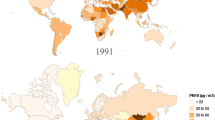Abstract
Aerosol samples were collected at Catania (Italy), from 16 March to 13 June 2005. The sampling was performed using a low pressure five-stage Berner cascade impactor. The samples were analysed for total aerosol mass, Water Soluble Organic Carbon (WSOC), Total Carbon (TC) and main inorganic ionic species. The Water-Insoluble Carbon (WINC) was derived by the difference: TC-WSOC. The samples share some common features: ammonium sulphate and carbon-containing species (both soluble and insoluble) are the largest contributors of fine particle mass, while coarse particles essentially consist of sea-salt, sodium nitrate and unaccounted PM (probably crustal material). The WINC/WSOC ratio decreases from the smallest size range to the large accumulation mode range (0.42–1.2 μm), while the \({\text{nssSO}}^{ = }_{4} \) and \( {\text{NH}}^{ + }_{4} \) contribution rises. The water-insoluble carbonaceous matter is the dominant component in the smallest particles (0.05–0.14 μm). We identified four different aerosol types, corresponding to different sources, contributing to the total particles load of the investigated urban environment: vehicular traffic, producing primary carbonaceous insoluble particles, secondary aerosols, dominating the composition of accumulation mode particles, and marine particles and mineral dust (both important components of the coarse aerosol fraction).









Similar content being viewed by others
References
Allen, A. G., Mather, T. A., McGonigle, A. J. S, Aiuppa, A., Delmelle, A., Davison, B., et al. (2006). Source, size distribution, and downwind grounding of aerosols from Mount Etna. Journal of Geophysical Research, 111, D10302.
Almeida, S. M., Pio, C. A., Freitas, M. C., Reis, M. A., & Trancoso, M. A. (2006). Source apportionment of atmospheric urban aerosol based on weekdays/weekend variability: Evaluation of road re-suspended dust contribution. Atmospheric Environment, 40, 2058–2067.
Cachier, H., Bremond, M. P., & Buat-Menard, P. (1989). Determination of atmospheric soot carbon with a simple thermal method. Tellus, 41B, 379–390.
Coe, H., Allan, J. D., Alfarra, M. R., Bower, K. N., Flynn, M. J., McFiggans, G. B., et al. (2006). Chemical and physical characteristics of aerosol particles at a remote coastal location, Mace Head, Ireland, during NAMBLEX. Atmospheric Chemistry and Physics, 6, 3289–3301.
Fujitani, Y., Hasegawa, S., Fushimi, A., Kondo, Y., Tanabe, K., Kobayashi, S., et al. (2006). Collection characteristics of low-pressure impactors with various impaction substrate materials. Atmospheric Environment, 40, 3221–3229.
Gelencser, A., Hoffer, A., Molnar, A., Krivacsy, Z., Kiss, G., & Meszaros, E. (2000). Thermal behaviour of carbonaceous aerosol from continental background site. Atmospheric Environment, 34, 823–831.
Heintzenberg, J., Muller, K., Birmili, W., Spindler, G., & Wiedensohler, A. (1998). Mass-related aerosol properties over Leipzig basin. Journal of Geophysical Research, 103, 13125–13135.
Kleeman, M. J., Schauer, J. J., & Cass, A. (2000). Size and composition distribution of fine particulate matter emitted from motor vehicles. Environmental Science & Technology, 34(7), 1132–1142.
Longley, I. D., Gallagher, M. W., Dorsey, J. R., Flynn, M., Allan, J. D., Alfarra, M. R., et al. (2003). A case study of aerosol (4.6 nm<Dp<10 mm) number and mass size distribution measurements in a busy street canyon in Manchester, UK. Atmospheric Environment, 37, 1563–1571.
Matta, E., Facchini, M. C., Decesari, S., Mircea, M., Cavalli, F., Fuzzi, S., et al. (2003). Mass closure on the chemical species in size-segregated atmospheric aerosol collected in an urban area of the Po Valley, Italy. Atmospheric chemistry and Physics, 3, 623–637.
Mayol-Bracero, O. L., Guyon, P., Graham, B., Andreae, M. O., Decesari, S., Facchini, M. C., et al. (2002). Black carbon, organic carbon and water soluble organic compounds in biomass smoke particles over the Amazon Basin. Journal of Geophysical Research, 107, 8091.
Motta, S., Librando, V., Minniti, Z., Federico, C., & Saccone, S. (2006). Identification of genotoxic compounds in the airborne particulate matter endowed by small aerodynamic diameter in the city of Catania (Italy). Journal of Analytical, Environmental and Cultural Heritage Chemistry, 96(9–10), 537–542.
Raes, F., Bates, T., McGovern, F., & van Liedekerke, M.(2000). The 2nd aerosol characterization experiment (ACE-2): General overview and main results. Tellus, 52B, 111–125.
Pio, C. A, & Lopes, D. A. (1998). Chlorine loss from marine aerosol in a coastal atmosphere. Journal of Geophysical Research, 103(D19), 25263–25272.
Putaud, J.-P., Van Dingenen, R., Dell’Acqua, A., Raes, F., Matta, E., Decesari, S., et al. (2002). Size-segregated aerosol mass closure and chemical composition. Monte Cimone (I) during Minatroc. Atmospheric Chemistry and Physics Discussions, 3, 4097–4127.
Putaud, J. P., Van Dingenen, R., Mangoni, M., Virkkula, A., Raes, F., Maring, H., et al. (2000). Chemical mass closure and assessment of the origin of the submicron aerosol in the marine boundary layer and the free troposphere at Tenerife during ACE-2. Tellus, 52B, 141–168.
Seinfeld, J. H., & Pandis, S. N. (1998). Atmospheric chemistry and physics—from air pollution to climate change. New York: Wiley Interscience.
Turpin, B. J., Saxena, P., & Andrews, E., (2000). Measuring and simulating particulate organics in the atmosphere. Atmospheric Environment, 34, 2983–3013.
Zanini, G., Pignatelli, T., Monforti, F., Vialetto, G., Vitali, L., Brusasca, G., et al. (2005). The MINNI project: An integrated assessment modeling system for policy making. In A. Zerger & R. M. Argent (Eds.), MODSIM 2005 International Congress on Modelling and Simulation (pp. 170–176. ISBN: 0-9758400-2-9). Modelling and Simulation Society of Australia and New Zealand.
Zappoli, S., Andracchio, A., Fuzzi, S., Facchini, M. C., Gelencsér, A., Kiss, G., et al. (1999). Inorganic, organic and macromolecular components of fine aerosol in different areas of Europe in relation to their water solubility. Atmospheric Environment, 33, 2733–2743.
Acknowledgements
This work was supported by MIUR, Rome, COFIN 2004, Project “Functional and Structural Characteristics of Atmospheric Particulate Organic Matter in Urban Areas”.
Author information
Authors and Affiliations
Corresponding author
Rights and permissions
About this article
Cite this article
Rinaldi, M., Emblico, L., Decesari, S. et al. Chemical Characterization and Source Apportionment of Size-Segregated Aerosol Collected at an Urban Site in Sicily. Water Air Soil Pollut 185, 311–321 (2007). https://doi.org/10.1007/s11270-007-9455-4
Received:
Accepted:
Published:
Issue Date:
DOI: https://doi.org/10.1007/s11270-007-9455-4




